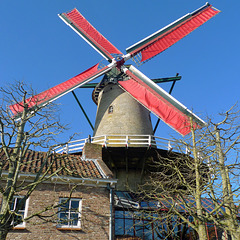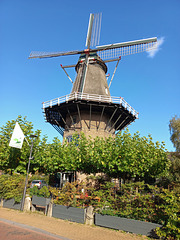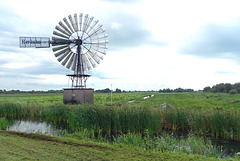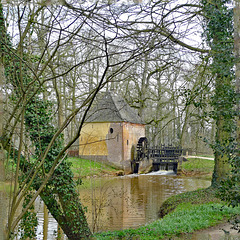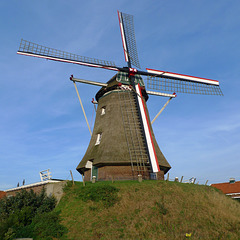
Nederland: wind- en watermolens
Folder: Nederland - the Netherlands
Foto's van Nederlandse wind- en watermolens.
Nederland - Schoorl, Kijkduin
| |
|
|
|
Relatively few of the 1.170 remaining windmills in the Netherlands were ever used to grind flour; instead, most worked as irrigation systems throughout the low-lying country. Even today many still function as backups for more modern Dutch water management systems.
Windmill Kijkduin - located in the village of Schoorl - is one of the country’s oldest working grain refinement mills. The windmill is a round stone ground sailer and was originally constructed in 1772. Even before 1575, there was a windmill on this site, which was set on fire by retreating Spanish soldiers in that year. It was not until 20 years later that a new mill - presumably a post mill - was built, which was demolished in 1771 and replaced by the current mill.
The mill was in regular use until 1935. After the Second World War, several restorations were carried out, and since 1973 the mill has been grinding again. Windmill Kijkduin is nowadays open to the public on Saturdays and grinding takes place when there is sufficient wind. The mill has a shop where various types of flour are sold to the catering industry, residents of Schoorl and tourists.
Nederland - Sint Maartensbrug, Noorder G
| |
|
|
|
The current Zijpe and Hazepolder was until the 12th a bog area, protected by the row of dunes from the North Sea. The reclamation of the peat for the benefit of farming led to the land being lowered and due to the rising of the sea level the area was endangered.
From around the year of 1600 the new polder was drained by twenty mills. Each mill took care of its own part (also called afdeling = section). The area was subdivided for this purpose and the 20 parts were assigned the letters of the alphabet (A to U, the letter J was not used).
On a map dating from that year there is no mill in the northern part of section G of the Zijpe polder . Probably this higher part of the section was not drained until around the middle of the 17th century. In 1664 there was at least a windmill. The current Noorder G polder mill is probably still the first original mill.
Until August 1958, this section was only drained using wind power. In that year the windmill was decommissioned and the paddle wheel removed. It was then replaced by a mortar with a diesel engine.
In 1969 the dilapidated windmill became the property of a foundation: Stichting De Zijper Molens . An external restoration was carried out between 1969 and 1972. After the motor mortar had been removed, the inside of the mill was reconstructed during the restoration at the end of 2003. In 2004 the mill was once again able to drain its section of the polder. Since then it is regularly put into operation.
Nederland - Sloten, De Kaai
| |
|
|
|
A map of Sloten - one of the Eleven Frisian towns - from 1523 shows a windmill in its present location for the first time. Windmill De Kaai was built in 1755 and is the successor to the earlier standerd mill that stood on this spot.
For many years it was known as De Korenmolen (The Corn Mill). It was given its ‘new’ name in 2006, derived from its position by the Lemster Poort - one of the two water gates in Sloten; where it stands on a bastion of the city wall.
De Kaai is a smock mill on a brick base with a thatched smock and cap. Its stage is 3.40 meters above ground level. The mill is winded by tailpole and winch. The sails have a span of 18.10 meters.
De Kaai still grinds wheat into flour in the traditional and authentic manner. On Saturdays, the mill is open for viewing and flour sales. The mill is listed as a Dutch national heritage site.
Nederland - Sluis, ‘De Brak’
| |
|
|
|
In the Middle Ages Sluis - a walled city - had a dozen mills. The only remaining windmill is‘De Brak’, named after a French breed 'Braque', a hunting dog always running with his nose in the wind.
The mill was built in 1739 and was the first in the region made of stone. The upper part of the smock mill can be put into the direction of the wind, which is called ‘kruien’ by the miller. From the stage one has a magnificent view over the city, the ramparts and further afield.
During World War II ‘De Brak’ was severely damaged; in 1950 began the reconstruction. The mill is now working as ever and is still used for grinding grain, which can be purchased in the mill store. ‘De Brak’ - located in the heart of Sluis - can be visited.
More info (Dutch): www.molendatabase.nl/nederland/molen.php?nummer=917
Nederland - Streefkerk
| |
|
|
|
Dutch polder landscape in the Alblasserwaard with a couple of windmills.
Picture taken along the Tiendweg nearby Streefkerk.
Nederland - Staverden, watermolen
| |
|
|
|
The watermill of Staverden is located on the place of a former flour mill along the Staverdense Beek. The oldest flour mill on Staverden dates back to 1307. The mill was demolished in 1923 and two years later replaced by the present farmhouse. The waterway was restored in 1989 by a provincial foundation for preservation nature and cultural heritage called ‘Het Geldersch Landschap’, the present owner of the mill. In 2000 a small generator was attached to the waterwheel in order to generate some green electricity for the surrounding buildings.
Nederland - Stevensweert, Hompesche Molen
| |
|
|
|
Count Reinier Vincent van Hompesch owned from the year 1719 the heerlijkheid (the lowest administrative and judicial unit in rural areas in the Netherlands) Stevensweert. He wanted his own banmolen (mill soke), in which the inhabitants of the villages Stevensweert and Ohé were obliged to grind their grains, so that the count could claim a part of the revenues. The mill was built between 1721 and 1722.
The Hompesche Molen is a so called stellingmolen (tower stage). From this stage (or platform) the miller could bring the sails in the right position. The mill has eight floors (called attics), including the basement, which was also used as a prison. The building is made entirely of brick and is round in shape. With a height of 37 meters it is the tallest flour mill in the province of Limburg.
During the Second World War, the mill was badly damaged and could not loger used. Between 1948 and 1949 it was restored, but the mill fell into disuse again and was in a worse condition, which led to another renovation between 1975 and 1977. After that, wheat and barley were milled for years by a voluntary miller for use as cattle feed.
Between 2005 and 2013 there has been a visitor centre in the outbuildings and miller's house. From 2009 a brasserie has been housed in the miller's house adjacent to the mill. In 2014 the mill became the property of the Vereniging Natuurmonumenten (a Dutch Society for Nature Conservation). In 2015 the mill was restored and made accessible to the public.
Nederland - Terwolde, ‘De Ooievaar’
| |
|
|
|
The current mill is the third one at this place. The first mill was a so called ‘grondzeiler’ with wings which came about two feet above the ground. The mill was built in 1854.by Abraham Ledeboer. Five years later the mill was sold to family Dieperink.
In 1896 the original mill was destroyed by fire. The second mill was a thatched stage mill and was used by the same family till the year of 1948, when it was bought by family Vorderman, well known millers in the region. In 1967, still in operation, the mill was restored for the first time.
Four years later the mill was destroyed again by fire. A local foundation took the initiative for rebuilding the windmill in Terwolde, 100 meters to the west of the old mill site. For the reconstruction the octagonal buck from the ‘Holtermansmolen’ from Deventer (most probably built in 1640 as a polder mill) was used.
In 1990 the reconstruction of ‘De Ooievaar’ (the Stork) was completed . Since then it houses one of the seven remaining operational flour mills in the Netherlands. But on 31 August 2015 the mill burned down again. Eearly May 2018- after the reconstruction - 'De Ooievaar' was opened to the public again.
Nederland - Texel, Het Noorden
| |
|
|
|
Windmill Het Noorden is an octagonal smock mill, which was built in 1878. The mill was used to drain the polder of the same name, in the northeastern part of the island of Texel. Later the need arose for a more powerful drainage system and a pumping station running on oil was added. The windmill became more and more out of operation and was shut down in 1923.
The mill was repaired in 1928, but was definitively decommissioned in the 1960s for the drainage of the polder. In September 2017 the Vereniging Natuurmonumenten (Society for Preservation of Nature Monuments in the Netherlands) became the owner of the windmill, after which a thorough restoration took place. Windmill Het Noorden - an iconic building on the edge of the polder - is currently once again in use by volunteers.
Nederland - Uitgeest, Tweede Broekermolen
| |
|
|
|
The Tweede Broekermolen is a windmill, which is very likely built in 1631. With four other mills, the mill drained the 1,800 ha large Uitgeester- and Heemskerkerbroek polder. The windmill is an octagonal polder windmill with a low, stone base and a wooden, thatched upper structure.
From 1866 onwards, the mill worked with a mortar, which had a diameter of 2 meters. In 1874, it was decided to increase the drainage of the polder with a steam pumping station, which was electrified in 1925. In 1874, it was decided to increase the drainage of the polder with a steam pumping station, which was electrified in 1925.
Some years later, the two remaining polder mills were sold. It was not until 1975 that the Tweede Broekermolen was made operational again. From 1989 on a major renovation took place. The mill - also in use as a home - is still operational, but only works on a voluntary basis.
Nederland - Vaassen, Daams Molen
| |
|
|
|
Daams Molen is dating back to the year of 1870. The mill was used by a cattle feed company as a windmill until 1934. In that year, the mill was dismantled and until round 1965 only electric milling was used.
For about twenty years the mill served only as a storage silo. In 1985, there were plans to demolish the mill. Fortunately the foundation Stichting Vaassens Molen made plans to restore the mill. Reconstruction of Daams Molen started in 1989 and one year later the mill was once again running in all its glory as a windmill.
During the restaorstion the original layout was changed quite a bit. Originaly the millstones were on the scaffold (not unusual in this region), but now placed one attic higher. Also, the mill used to be covered not with thatch, but with wood and roofing leather.
As of 2008, the mill was in full discussion because of plans to partly renovate and add new buildings to the center of Vaassen. Due to the expected reduced wind catch, it was necessary to raise the mill. This work started in March 2012. First, the overhead part of the mill was moved about 30 metres, across the street. Then a new foundation with basement was made on the actual site. In May the mill was brought back on the new foundation.
In September the raised Daams Molen was officially put into operation as a grinding mill again.
Since April 2014 the groundfloor houses a lunchroom: Koffie-en Theehuys 'De Korenmolen .
Nederland - windmotor De Veenhoop
| |
|
|
|
Windmotor De Veenhoop is a polder windmill near the Frisian village of De Veenhoop. It is a so called American windmill (in the Netherlands also called roosmolen ). This type of windmills was developed in the United States and was used for irrigation purposes. In the Netherlands, these mills are used as polder mills. De Veenhoop is of the brand Herkules and was built in the German city of Dresden.
From 1921 to 1962, the mill was used for draining a nearby polder. The mill was sold, but in 1996 it was in very poor condition. Five years later, the mill was refurbished and used again at its present location to drain the Groote Veenpolder .
Nederland - Veere, De Koe
| |
|
|
|
Windmill ‘De Koe’ (The Cow) is a grain mill in Veere, where it is located on one of the earth walls of the fortress just outside the city. It is a round brick mill, dating back to the year 1909. ‘De Koe’ is built on the location of an older mill from 1736, which was burnt down.
Documents mention a mill named ‘De Coe’ already in 1599, so the current mill is most probably the third with this name. During that time there was also a mill named ‘De Stier’(The Bull).
The mill has a reefing stage (‘stelling’) and the cap is covered with zinc. The upper part is white painted, which is a tradition in the Dutch province of Zeeland. It has a flight of 23.50 meters. The mill is no longer used as the ground floor houses nowadays a holiday home.
Nederland - Vorden, Watermolen Hackfort
| |
|
|
|
The Watermolen Hackfort is located on the estate Hackfort , close to the castle of the same name. The mill was first mentioned in the year 1442, while the current square stone building was built around 1700. The mill is equipped with a water wheel with blades and is powered by water from the Hackfortse Beek. The water wheel drives millstones to grind grain. The water mill also supplies electricity to the electricity network.
In 1952 the mill was shut down because of the poor condition of the wheel and building. At that time the stream also contained too little water to power the mill. In 1981, the estate (with castle and mill) passed into the hands of the Natuurmonumenten and was refurbished. After the water board had ensured that sufficient water flowed through the Hackfortse Beek, a new water wheel was installed in 1998.
Since that moment the mill has been in use. Volunteer millers are sawing wood and grinding grain for cattle feed on hydropower. On Saturdays and on special occasions the mill is open to visitors.
Nederland - Vorden, Watermolen Hackfort
| |
|
|
|
The Watermolen Hackfort (Hackfort Watermill) is located on the estate Hackfort , close to the castle of the same name. The undershot watermill was first mentioned in the year 1442, while the current square stone building was built around 1700. The mill is equipped with a water wheel with blades and is powered by water from the Hackfortse Beek. The water wheel drives millstones to grind grain. The water mill also supplies electricity to the electricity network.
In 1952 the mill was shut down due to the poor condition of the wheel and building. At that time the stream also contained too little water to power the mill. In 1981, the estate (with castle and mill) came into the hands of the Natuurmonumenten (a Dutch society for preservation of nature monuments) and was refurbished. After the water board had ensured that sufficient water flowed through the Hackfortse Beek, a new water wheel was installed in 1998.
Since that moment the mill has been in use. Volunteer millers are sawing wood and grinding grain for cattle feed on hydropower. On Saturdays and on special occasions the mill is open to visitors.
Nederland - Vorden, Lindesche Molen
| |
|
|
|
The ‘Lindesche Molen’ (also called ‘Molen Ons Belang’) is an octagonal ‘belt mill’. The ‘belt (= a man made hill) for this mill has a height of 4.20 metres. These ‘belts’ were made in order to provide more wind for the mill.
The present mill was built in 1890 on the site of an even older mill (1856), which burned down. The mill wasn’t used for many many years. In the year of 1971 it was restored and the sails could turn again. Twenty years later mill stones were placed and the mill was ready for grinding flour again.
The ‘Lindesche Molen’ is situated in the hamlet Linde, nearby the town of Vorden and along the ‘Achtkastelen route’ (Eight Castles route); a bike route along eight castles/mansions.
Nederland - Vorden, Watermill Hackfort
| |
|
|
|
Watermill nearby Castle Hackfort (Vorden) along the 'Hackfortse Beek'. The mill is dating back to the year 1700.
Nederland - Vreeland, Hoekermolen
| |
|
|
|
The Hoekermolen is a polder mill, which already appears on a map before the year of 1639. The current mill was built in 1874 on the site of an earlier mill, which burned down in that year after lightning struck. That new mill was a redundant Amsterdam industrial mill.
The Hoekermolen drained the polder until 1959. In that year, the polder was connected to the Garstenpolder and the drainage was taken over by an electric pumping station. Around 1963 the mill was restored and sold. It was stipulated that the windmill should always remain available as a back-up pumping station for the combined Hoeker-Garstenpolder. The Hoekermolen therefore always remained operational and actually had to step in once in 1994.
In 2005/2006, the windmill was thoroughly restored once more, and a longer screw pump was installed in order to cope with the lowered polder level.
Jump to top
RSS feed- Latest items - Subscribe to the latest items added to this album
- ipernity © 2007-2026
- Help & Contact
|
Club news
|
About ipernity
|
History |
ipernity Club & Prices |
Guide of good conduct
Donate | Group guidelines | Privacy policy | Terms of use | Statutes | In memoria -
Facebook
X




